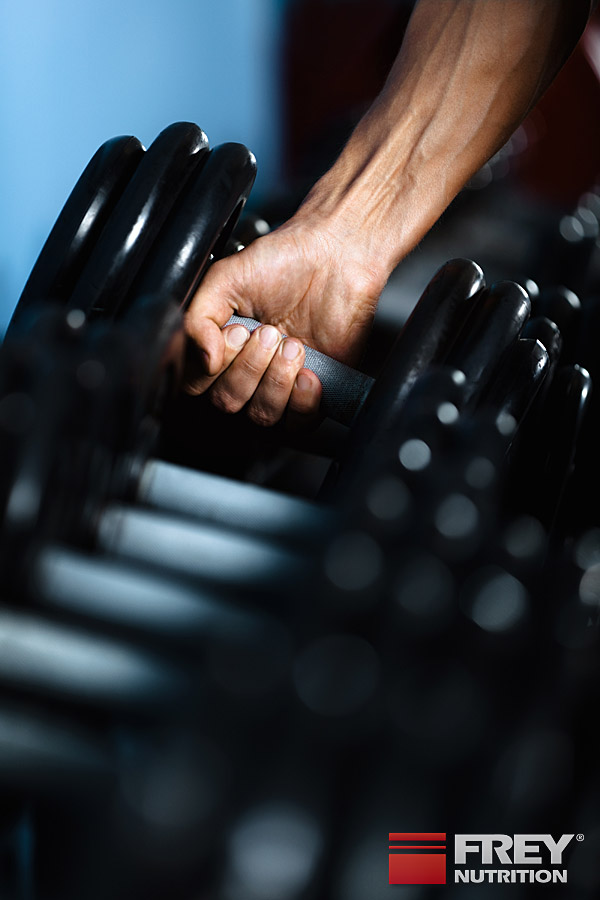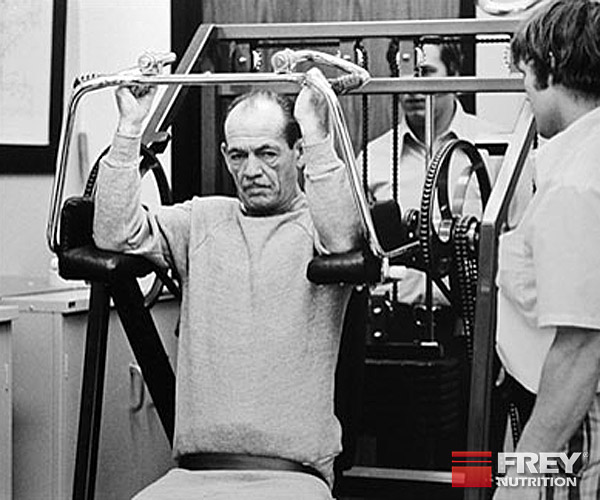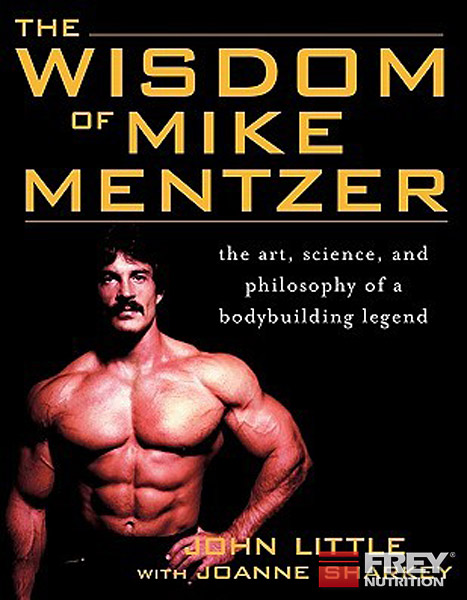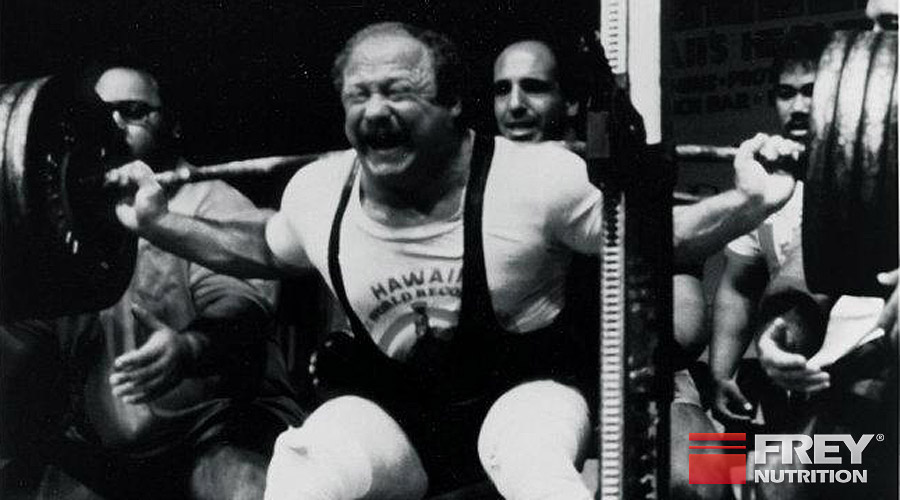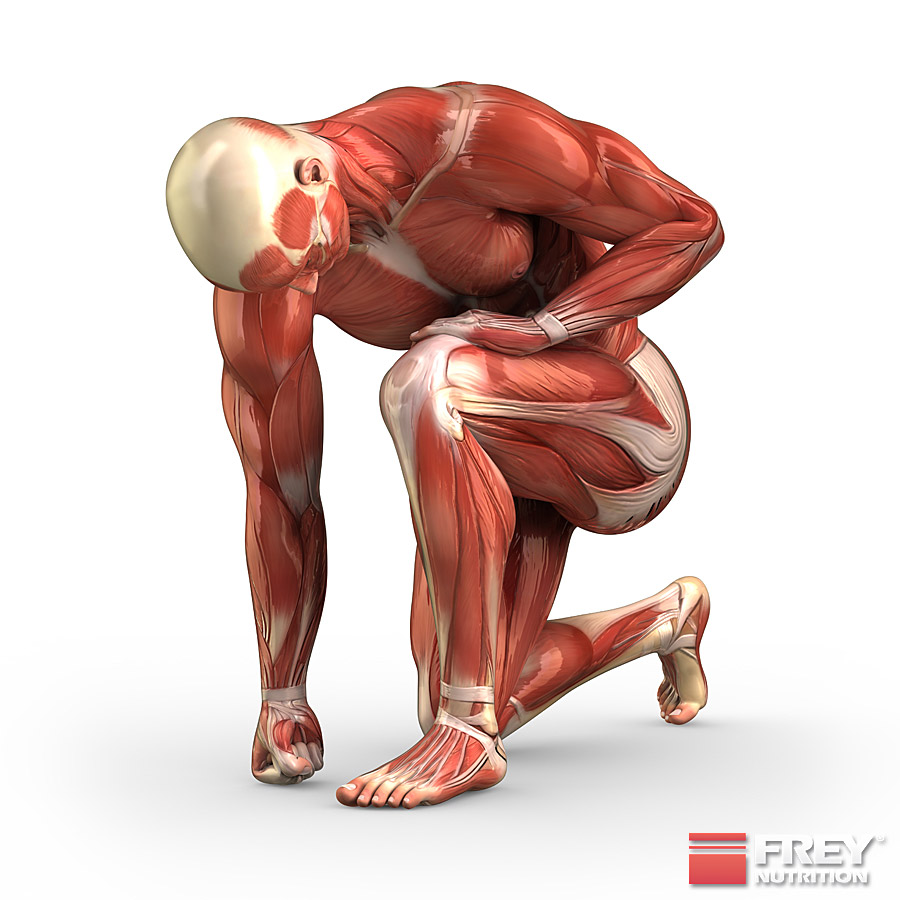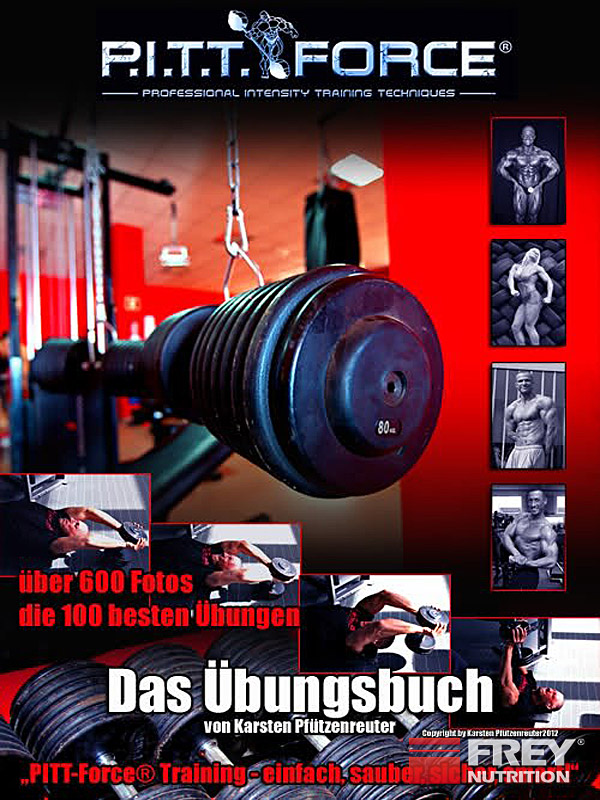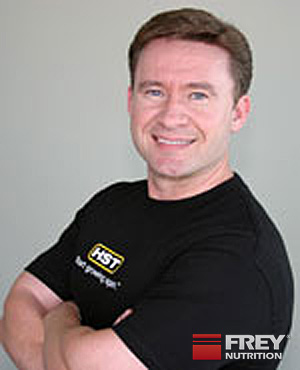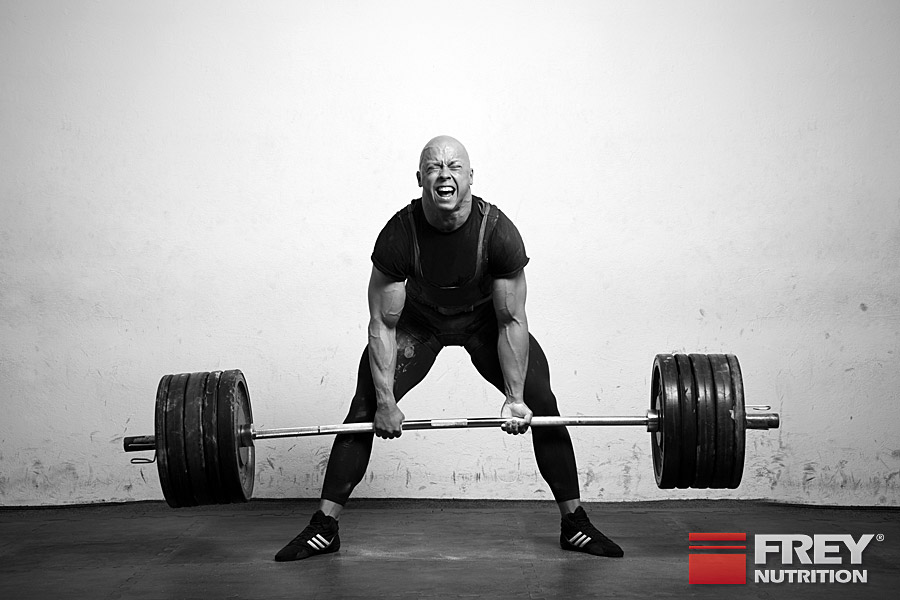IS THERE AN ULTIMATE TRAINING METHOD?
Is there such a thing as the ultimate training method, the method of training that works 100% and guarantees this in the long term? The answer is: "NO - unfortunately there isn't one!" Otherwise, the following part about the different training methods would probably be superfluous and would only describe one.
Nevertheless, print media regularly try to convince us of the opposite, month after month, by presenting groundbreaking new training systems that are supposed to lead to massive muscles or defined six-pack abs in the shortest possible time. Such articles are not written to work in practice, but to boost sales and turnover of their print magazines. The articles are written as if these extraordinary training systems were written personally by professional bodybuilding celebrities, so that the reader assumes that the theory in question simply MUST be true. "A professional knows how to do it. After all, he is a professional, isn't he?" He knows this for sure and uses his knowledge. However, he is also professional enough to keep his personal training strategies to himself and not to make them available to an audience of millions or his competitors.
That's why many of the sensationalist articles with numerous flimsy promises of rapid and massive muscle growth are usually not written by professional bodybuilders, but rather by experienced editors who know very well how to make texts and the statements they contain as credible and convincing as possible. But be careful, because you shouldn't believe everything that the print magazines try to "sell" you! That's why you should always be critical of new and incredibly effective training systems and with a little basic knowledge it will be possible to distinguish effective from useless training forms and principles.
The basic knowledge required for an evaluation of training methods and the basic information about various types of training form the basis of this article. It goes without saying that not all of the training methods in circulation can be explained, as there are countless of them and new ones are added every day - unfortunately, because that doesn't make the choice any easier. Therefore, only the most well-known training methods are explained, their usefulness is highlighted and their advantages and disadvantages are mentioned.
HIGH INTENSITY TRAINING (HIIT)
The basis of high intensity training (HIT for short) is short, intensive and very hard training units, which are accompanied by a sufficient regeneration period of several days.
Arthur Jones (entrepreneur, sports equipment manufacturer and inventor of the Nautilus machines from the 1970s) and the bodybuilder Mike Mentzer through his book Heavy Duty were primarily responsible for the spread of HIT.
THE BACKGROUNDS
Jones was inspired to develop HIT by his hobby as a big game hunter. When observing lions, he drew logical conclusions between the intensity of an animal's physical exertion and the development of its muscles. While female animals spent the whole day gathering food for their young, males slept the whole day. During the hunt, however, the males showed an exceptionally strong intensity in sprints and jumps. Jones concluded that the muscle mass of the male animals could not only be attributed to their hormonal conditions, but also to the short and very intense exercise intensity during the hunt, followed by sufficient rest and recovery phases that were used for muscle regeneration. He therefore made the following recommendations for bodybuilding training: "intense, short and infrequent".
THE IMPLEMENTATION
The aim of HIT is to stimulate the muscle to grow with highly intensive but very short training loads, whereby each set of a training session must lead to muscle failure.
Mike Mentzer, a successful bodybuilder from the 1980s, was the first to follow and advocate HIT. He came up with the so-called seven-second rule, which is intended to describe the sequence of a repetition: three seconds for the positive movement, one second for muscle tension (= muscle contraction) and three seconds for the downward movement, the negative sequence of a repetition. For HIT, a working weight must be chosen with which 6 to 10 repetitions can be achieved, with each repetition being performed cleanly and in a controlled manner. A maximum of 2 sets may be performed per exercise, and no more than 10 sets in total per training session. The goal of each set is to achieve muscle failure at certain points. A training session should last a maximum of 60 minutes. The opposite training method to HIT is classic volume training, which was favored by Arnold Schwarzenegger, among others.
THE HIT IS ONE OF THE MOST USEFUL TRAINING METHODS.
THE ADVANTAGES
1. OPTIMAL HORMONE RELEASE
Various studies prove that intensive training promotes the release of anabolic (= muscle-building) hormones and that these reach their highest point after about 45 to 50 minutes. However, after about 50 to 60 minutes, the release decreases and the production of catabolic (= muscle-degrading) hormones increases dramatically. Therefore, the optimal duration of a training session is limited and should not be longer than one hour. Limiting the training time is a fundamental principle of HIT, which results in optimal hormone release.
2. LOW TIME CONSUMPTION
While a conventional training session usually lasts 1.5 to 2 hours or longer and is carried out at least 3 times a week, or even 5 times for advanced users, HIT takes significantly less time. Three training sessions of 45 minutes each per week are enough to achieve results faster and with less effort than with conventional training. However, this requires maximum intensity and compliance with the rules underlying HIT.
3. CLEARLY DEFINED RULES
Clearly defined rules promote motivation and make it easier to achieve success. The rules of most training programs are rather vague and can therefore be interpreted more or less broadly, which increases the likelihood of ambiguities and misunderstandings. HIT, on the other hand, defines clear rules that must be followed in order to be successful, making it much easier to implement. "Push yourself to the limit, reach muscle failure and keep the workout short!" are clear guidelines that everyone can understand and implement.
4. OVERTRAINING IS NOT POSSIBLE
The biggest enemy of any training method is overtraining, as this not only prevents the development of new muscle mass, but can even break down existing muscle mass. The basics of HIT prevent overtraining from the ground up by only allowing training to resume after recovery and adaptation are complete.


HIT is one of the most sensible, if not THE most sensible, training method. Many successful professional bodybuilders train according to it and HIT enjoys an excellent reputation in bodybuilding circles. The principles underlying HIT are based on the biological processes of muscle building, using a sufficiently long regeneration time for this, because muscles only grow during recovery and not during training. Anyone looking for disadvantages of HIT will be disappointed, because there are none. Clearly: thumbs up!
VOLUME TRAINING
A high volume of sets and sometimes long training sessions make up this training system. Arnold was one of the biggest advocates of volume training and still promotes its effectiveness today. It was not uncommon for 20 to 30 sets to be completed per muscle, with a training session lasting up to 3 hours.
What was considered the ultimate solution back then is now long out of date and has been refuted by numerous studies. The training simply provides the muscle with a stimulus, i.e. a warning signal to become stronger and larger in order to be able to cope better with the training load next time. This training stimulus does not require countless sets of moderate intensity, but rather a few sets of maximum intensity, in order to give the stressed muscle enough time to recover afterwards. The unnecessarily long training time makes it difficult for the user to build muscle effectively, as the body releases catabolic hormones due to the long load, which can not only reduce muscle growth, but also cause existing muscle to break down. Studies have shown that the level of cortisol, an anti-inflammatory hormone with a strong catabolic (= muscle-breaking) effect, was released in increased amounts. This is why it is generally recommended not to train for longer than 60 minutes per training session. This is a principle that is incompatible with volume training, which makes it unsuitable as an optimal training system for building muscle.
VOLUME TRAINING CAN QUICKLY LEAD TO OVERTRAINING.
Athletes who follow this training method act according to the motto: "More is better - more is even better!" Add to that the guilty conscience, which causes many to train much more than is necessary to build muscle. However, this theory has already been refuted several times, because bodybuilding is all about short and targeted training stimuli so that the muscles are given enough time to recover.
Volume training is therefore less suitable for building muscle in bodybuilding, but rather for fitness sports, where the focus is primarily on endurance performance and not on maximum muscle growth.
If you are interested in Arnold's training philosophy and the background, the film "Pumping Iron" is highly recommended. It's worth watching, especially since "Pumping Iron" is not only THE cult film of all time, but also provides an entertaining illustration of the background of bodybuilding in the 70s and 80s.
For professional athletes who have turned their hobby into a profession, volume training can work because it allows them to ensure adequate rest and regeneration. This is difficult for a hobby athlete with professional commitments.


Since volume training demands a lot from you, the risk of overtraining is very high. While this may not have a negative impact on professional bodybuilders, who have sufficient recovery phases, it can be a sure path to overtraining for normal trainees.
The principles of volume training are outdated, have been refuted several times and do not correspond to the biological processes of muscle building and supercompensation, both of which are based on the cornerstones Stimulus : Regeneration : Growth Regeneration is clearly neglected in volume training, which is why muscle building cannot proceed optimally. For this reason, the volume system is a training method that should rather be discouraged.
PERIODIZATION
The typical periodization divides the training into different cycles, taking into account the specific goals set. A distinction is made between the microcycle (about 1 week) and the mesocycle (4 to 8 weeks); in summary, this results in the annual cycle or macrocycle and describes the training up to a certain point over several months. In short, periodization means dividing weight training into 3 specific periods based on specific goals, which are explained below.
THE 3 PHASES OF PERIODIZATION
THE 1ST PHASE - IK TRAINING
The first phase is IK training (intramuscular coordination), which is performed with 2 to 6 repetitions. IK training hardly builds up any muscles, but it does increase strength and tightens the muscles by improving intramuscular coordination. After this phase, you move on to the second phase.
THE 2ND PHASE - MUSCLE BUILDING
The training in the second phase aims at maximum hypertrophy and specifies a repetition range of 6 to 12 repetitions. In this phase, the attempt is made to use the previously gained strength over a length of 6 to a maximum of 12 repetitions. The goal is the maximum increase in muscle mass. Then you move on to the third phase.
THE 3RD PHASE - MUSCLE ENDURANCE
In the 3rd phase, around 20 repetitions or more should be performed per set. The aim of the 3rd phase is to maximize muscle endurance and capillarization of a muscle by increasing its capillaries. To achieve these goals, many repetitions must be performed per set. Another goal is to increase the number of mitochondria in the muscle, thus leading to an economization of metabolism. In this phase, the blood flow to the muscles is increased and the increase in the number of mitochondria in the muscle prepares it for the subsequent IK training, i.e. the transition to the 1st phase.
ITS WEAKNESSES MAKE PERIODIZATION RECOMMENDED ONLY TO A LIMITED EXTENT.
Periodization makes sense in theory, but there are some limitations that greatly reduce its effectiveness. The main negative point is the lack of adaptability of the muscles when changing from one cycle to the next. The muscles need far too long to adapt sufficiently, especially at the beginning of a single phase, which greatly hinders the achievement of progress. This phenomenon occurs especially when changing from the 3rd phase of local muscle endurance with 20 repetitions to the 1st phase of IK training with 2 to 6 repetitions. The strength output after the change is far below the strength output that was previously achieved in the IK training phase, which is why a new phase adaptation of the muscles is necessary.
The second problem is the fact that moving to the next phase prevents further improvements. Phases that are set in advance in terms of length often end up being completed even though further improvements would have been possible, which does not represent sensible training. Anyone who has already used the system for several months will certainly be able to confirm the problem described, which is why periodization is only a limited training method.


While periodization is a training method that makes sense in theory, its weaknesses usually only become apparent in practice. However, periodization can be beneficial for preparing for a competition in athletics if it is used specifically for preparation. However, in order to achieve maximum performance in a competition, the last phase before a competition should correspond to the respective discipline. For example: IK training = sprint discipline. Muscular endurance = marathon.
Since the adaptation of the muscles to the respective phase is slow and muscle building is therefore significantly limited, periodization in the sense of year-round training is less suitable for fitness athletes or bodybuilders and is therefore only recommended to a limited extent.
HATFIELD SYSTEM
The Hatfield system goes back to Dr. Frederick Hatfield (born October 21, 1942), who was also known as "Dr. Squat." Fred Hatfield made a big name for himself in the powerlifting scene at the time by setting numerous national and international records in powerlifting, some of which have not been broken to this day.
For the "older" readers among us, the name "Hatfield" is probably synonymous with tremendous feats of strength. For Dr. Squat, squats with a massive 400 kg on his shoulders were practically his daily bread. In 1989, Hatfield was appointed assistant coach of the American Powerlifting Association and during this time wrote four training books on the subject of bodybuilding and powerlifting. In later years, he became involved in many other sports, such as wrestling under the umbrella organization of the former World Wrestling Federation (WWF), and helped with the development and research of nutritional supplements.
But he only really became famous through his training program of the same name, the Hatfield System, which enjoyed great popularity among numerous bodybuilders in America. His book "Bodybuilding - A Scientific Approach" is still part of the basic literature of every inquisitive bodybuilder and strength athlete. In his books he explained his training principles with scientifically based facts. The goal that Hatfield had in mind was the targeted, effective stimulation of a muscle in order to force it to adapt (= adjust), i.e. to build muscle.
THE HATFIELD TRAINING BASICS
He summarized the principles established by Fred Hatfield in two ways:
1. THE SAID PRINCIPLE ( S PECIFIC ADAPTIONS TO I MPOSED D EMANDS)
The SAID principle states that specific stresses lead to specific adaptations in the body. Muscle cells consist of different elements and therefore respond best to different stimuli.These stimuli pass through different numbers of repetitions in different repetition ranges. So not only low repetitions are important for muscle growth, but also those in a medium and high repetition range. The different stimulation of the muscle fibers leads to a holistic load and thus to a greater growth potential. Hatfield also called his training system the holistic principle, which is nothing other than holistic training.
2. THE OVERLOAD PRINCIPLE
In order to achieve further adaptation, a stronger or different stimulus than the previous one must occur after each successful adaptation phase. At this point, it becomes important to differentiate between the muscle fiber types.
The FT fibers (type 2 fibers): The FT fibers (= fast twitch) or "white fibers" are of crucial importance for strength athletes because they are used particularly during short, intense efforts and are therefore strongly stimulated. They can contract very quickly, develop considerable force and have the greatest capacity for hypertrophy, i.e. muscle growth. However, because they have poor blood circulation, they tire very quickly.
The ST fibers (type 1 fibers): The ST fibers (= slow twitch) or "red fibers" are important for endurance. They provide constant energy over a long period of time and are primarily used for longer periods of low intensity exercise.
THE TRAINING SYSTEM
Due to the different load ranges and the resulting increased complexity, the Hatfield system is not the optimal training program for beginners and should only be used once you have already become familiar with and practiced the different repetition ranges according to conventional periodization. The more muscle mass there is, the more effective the Hatfield system is for training success and muscle building.
In contrast to classic periodization, Dr. Fred Hatfield recommends an approach in which all three repetition areas, i.e. IK training, muscle building and muscle endurance, are carried out in parallel throughout the year. As already mentioned, he describes this form of training as the holistic training system. The advantage of this system is that it excludes the possibility of a lack of adaptation from one training phase to the next, which effectively avoids the biggest disadvantage of periodization. Since you carry out all three phases in one training session and throughout the year, you can take advantage of all the benefits without accepting any loss in strength or muscle endurance.
"I HAVE BEEN TRAINING ACCORDING TO THE HOLISTIC PRINCIPLE FOR OVER 15 YEARS AND IN TERMS OF MUSCLE BUILDING, BLOOD CIRCULATION AND VARIETY THERE IS NO COMPARABLE SYSTEM." (QUOTE: A. FREY)
Furthermore, from a biological point of view, this theory is both plausible and effective, because the body cannot achieve goals one after the other and at the end of a year be equally successful in all three phases - one phase will always dominate, while the other two will always lag behind. Only the parallel strain on the muscles through different repetition ranges can lead to success in all three phases at the same time.
Since the Hatfield system is very intensive and naturally requires much more than conventional training, special attention should be paid to correct movement execution. This not only effectively prevents overtraining, but also significantly reduces injuries.


The Hatfield system is clearly one of the most effective training methods ever. The inventor not only thought about a possible high level of muscle adaptation, i.e. the muscle building resulting from the muscle stimulus, but also included biological factors as an additional component.
As a coherent training principle based on logical principles with a holistic character, Hatfield training is only partially suitable for beginners, but is all the more effective for advanced users. In addition to the variety, the disproportionately strong muscle pump has an extremely positive effect on motivation and makes the system feasible in the long term - because let's be honest, who doesn't find the feeling of maximally pumped up muscles unique?! Clearly: thumbs up!
PITT FORCE
PITT-Force is now a well-known and successful training program that is used by many successful athletes. Initiated and developed by the legendary bodybuilder Karsten Pfützenreuter, PITT-Force combines various training approaches in one system, with the single repetition forming the basis of the system. The goal is maximum strain on the muscles and the resulting increased hypertrophy compared to conventional training principles.
* from left to right: Andreas Frey, Carsten Jürgensen, Diana Bayer, Mark Baumgart, Nicole Pfützenreuter, Karsten Pfützenreuter, Peter BaersTHE BASIC IDEA OF PITT-FORCE
The basic idea behind PITT-Force is to perform a series of individual repetitions as often as possible in succession, alternating with extremely short recovery phases of just a few seconds. This approach creates an interplay between stress and recovery in order to intensify the muscle stimulus.
Because the muscle is given recurring recovery phases, lactic acid production - we all know the feeling of muscle burning during the last repetitions of a set - can be significantly delayed, which allows for significantly more repetitions than is possible with a conventional training set. The short recovery breaks allow for increased blood flow to the muscle and ensure optimal breakdown of waste products and the supply of new nutrients that can be used to build muscle. Because the repetitions are always carried out individually, there is significantly less cheating than is often the case with sets with, for example, more than 12 repetitions.
Since PITT-Force requires a certain amount of training experience, beginners should (still) avoid this principle and practice conventional training methods with 6 to 10 sets per muscle and a repetition range of 8 to 12. Only with increasing experience can PITT-Force be carried out effectively and, above all, injury-free. PITT-Force is an effective training system for all athletes with basic experience as well as for advanced athletes, and above all for overcoming plateaus and creating an unusual stimulus for the muscles. Numerous athletes, such as the German champion Peter Baers, to name just one, have shown that the system, even when used on a long-term basis, enables above-average success.
PITT FORCE TRAINING PROCESS
First of all, the right weight is chosen for an exercise. As a guideline, this should be just high enough to allow at least 8 clean repetitions. After the 8th or 9th repetition, the weight is put down for a set break of three to a maximum of five seconds, and then another repetition is continued. This procedure is carried out until no more clean repetitions are possible.
For advanced athletes who train at a high intensity, the rest time can be extended - but it should always be under the maximum of 20 seconds. A training session per muscle consists of a maximum of 5 sets. If carried out correctly and as prescribed, it should be possible to bring the target muscle to complete exhaustion within these 5 sets.


Even though PITT-Force is aimed more at advanced athletes and cannot be recommended for beginners, PITT-Force is clearly one of the most effective training methods, enables solid muscle building and, above all, the possibility of effectively overcoming plateaus due to the differentiated muscle stimulus.
In a slightly modified form, PITT-Force is also suitable for intensifying an existing training system by performing a pump set with 3-4 consecutive sets at the end of each muscle group (see also pump set in the Hatfield system).
HYPERTROPHIC SPECIFIC TRAINING (HST)
Hypertrophy-Specific Training is a relatively new training method in bodybuilding and strength training that is characterized by short but frequent training sessions. In contrast to almost all other training principles, HST does not involve training to the point of muscle failure.ORIGIN AND DISTRIBUTION
Brian Haycock is the inventor of HST training. After 23 years of strength training, Haycock set about developing a new training system that was to be fundamentally different from previous systems. His motivation was simply to overcome his own plateaus, especially since the existing principles did not work for him. HST was created in October 2000, spread relatively quickly, among other things through the newsletter on the homepage www.ThinkMuscle.com and the Internet as a new medium, and enjoyed great popularity in a very short time.
In order to develop the system with the greatest possible effectiveness, Haycock focused primarily on the scientific basis of muscle growth and recognized that conventional training systems in bodybuilding did not take the latest scientific findings into account. With HST training, he therefore attempted to implement the scientific relationships between stress on the one hand and muscle growth on the other hand in a simple, coherent training system.
THE 4 PRINCIPLES OF HST
1. MECHANICAL LOAD
The muscle must be mechanically stressed in order to grow. A number of complex biological processes, such as MAPk and ERK, play an important role in hypertrophy. HST uses these processes to help develop special training rhythms and integrates them into a given training plan.
2. FREQUENT TRAINING LOAD
Since scientific studies have shown that the muscle size returns to its original level after just 36 to 48 hours, the muscle must be stressed again after this time at the latest.
The second principle of HST is therefore to place frequent strain on individual muscles in order to stimulate sustained hypertrophy. According to HST, each muscle group should therefore be subjected to at least 3 training sessions per week. If the strain is lower, the breaks would be too long, meaning the muscles would not be constantly stimulated and would deteriorate. However, in one training session it is sufficient to perform only one or two sets per exercise, which should not go to the point of muscle failure.
3. PROGRESSIVE WEIGHT INCREASE (PROGRESSIVE LOAD)
Since it has been found that the muscles can adapt to a certain load (e.g. the last training session) within 48 hours, which makes further muscle growth under the same load no longer possible, the training weight should be continuously increased with each training session during Hypertrophic Specific Training.
4. STRATEGIC DECONDITIONING
Since the frequent training sessions per week place a great strain on the body and the body no longer responds to the training stimuli with muscle growth at a certain point, regular regeneration breaks are the fourth principle of HST. These rest days allow the muscles, as well as the strained ligaments and tendons, to recover and can also be used for endurance sessions. However, these should not exceed a maximum length of 40 minutes.
The following summary can be derived from these four basic rules:- The training weight must be steadily increased or at least remain constant, but must never be reduced.
- If a weight is too high, the weight is never reduced, only the number of repetitions.
- At least 3 training sessions per week must be completed for each muscle group.
- Training must be stopped before muscle failure occurs.
- It is enough to do 1 to 2 sets per exercise.
- The rest days must be observed.


As a very new training method, Hypertrophic Specific Training uses completely new approaches and departs from the path of conventional training. While almost all other training principles have muscle failure as their main goal, reaching this is strictly prohibited with HST. Due to the completely divergent approaches, HST can be used very well as a supplement to existing training methods. This could help overcome plateaus and stimulate muscle growth again through the unusual and new stimuli.
The frequent training sessions, i.e. always a full-body workout in a 3-day training session, have a big advantage over the basics of shorter and less frequent training according to HIT or PITT: the muscles are constantly supplied with nutrients due to the frequent blood flow and are stimulated continuously, although not maximally. Although we believe that HST reaches its limits more quickly than is the case with HIT, for example, it is still a useful supplement and can therefore be recommended without reservation!
GERMAN VOLUME TRAINING (GVT)
THE BACKGROUNDS
German Volume Training dates back to the 1970s and was used by German weightlifters to build muscle in the off-season. It was later taken up again in the United States by legendary trainer Vince Gironda and today by the respected strength coach Charles Poliquin and used for supporting athletes. Due to its German roots, the name "German Volume Training" (GVT) was created.
The GVT aims to build muscle as quickly as possible and is aimed primarily at advanced athletes. The system cannot be recommended for beginners because the intensity is too high and there is a very high risk of overtraining.
THE BASIC PRINCIPLES
German Volume Training, which is similar to volume training, is, as its name suggests, about sets and as many of them as possible. The system prescribes ten sets for each exercise, each of which should be performed with ten repetitions. Since this type of training is very hard, but also very effective according to GVT, the training weight should be 60 to 70% of the maximum weight (maximum weight = the weight with which a clean repetition is possible), which corresponds to a moderate range.
A maximum of 2 exercises should be chosen per muscle, one basic and one isolation exercise. The rest time between two sets is prescribed and is one minute. To ensure that this is adhered to correctly, the use of a stopwatch is recommended, which is generally a good idea. If you manage the 10x10 system with a training weight, it should be increased in the next training session, although the increase should be fairly small. Carles Poliquin recommends an increase of just 4 to 5%. Since rapid and maximum muscle building is the main goal, extensive endurance sessions should be avoided.
Each muscle group should only be used once per week and a rest day is prescribed after each training day. If this is not adhered to, muscle growth can stagnate due to fatigue and negate the effect of muscle building. 10 sets per exercise sounds like a lot at first, but this number is put into perspective by the reduced choice of exercises. With 20 sets per muscle, significantly more sets are still completed than is the case with HIT, but fewer than with typical volume training, where more than 30 sets are often done for one muscle. If muscle strength decreases during a set, the training weight should not be reduced under any circumstances, only the repetitions of a set.
The GVT assumes a training period of 6 weeks. Afterwards, it is recommended to continue with conventional muscle building training in the repetition range of 8 to 12 repetitions or to resort to other training methods. This is therefore not a system that claims to enable permanent progress, but is clearly only designed for a limited area, which makes it useful at best for overcoming plateaus.


Because of its few exercises, the GVT is very simple and clear, but also quite monotonous, which means that motivation quickly disappears. It is also difficult to achieve a holistic strain on an entire muscle with just two exercises. The GVT is not suitable as a long-term training system, but at best as shock therapy to stimulate new growth in the muscles. The GVT is more suitable for weightlifters than for bodybuilders, since for the former group only a few exercises, such as squats, squats and bench presses, are important anyway, and so the small number of exercises does not have a negative impact. Since the GVT is neither designed nor suitable for long-term use, it can only be recommended to a limited extent.


